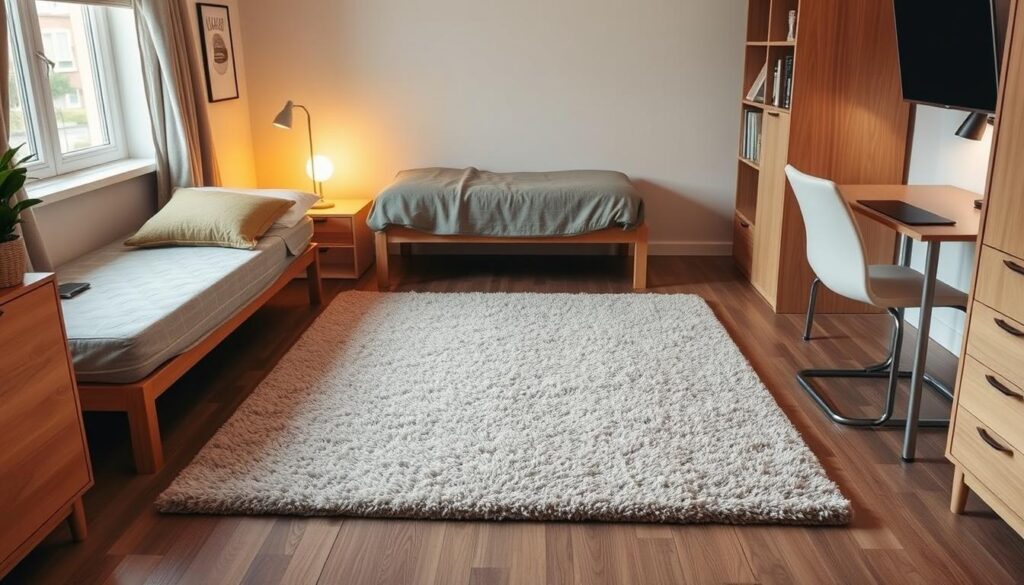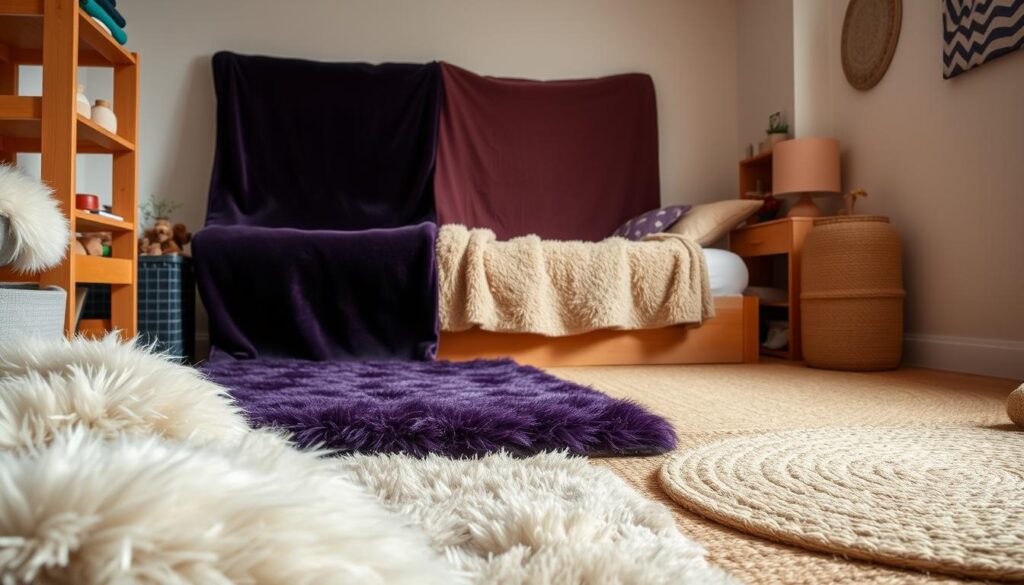Floor Solutions for College Living Spaces
Find the best rugs for dorms that are perfect for college living. Our buyer's guide covers the top-rated rugs that won't slide or shed, ensuring a cozy dorm room.
Moving into a dorm room marks an exciting chapter in college life, but cold floors and bare surfaces can make these spaces feel impersonal. Many first-time students discover that functional floor coverings are essential for transforming sterile environments into cozy, practical living areas. With shared spaces and frequent foot traffic, selecting the right solution requires balancing comfort, durability, and budget.

Common dorm flooring materials like tile or linoleum often lack warmth and amplify noise. A well-chosen floor layer adds personality while addressing practical needs like insulation and sound dampening. Students must prioritize options that stay securely in place on smooth surfaces and resist wear from daily use.
Maintenance is another critical factor. Spills, dirt, and frequent cleaning demand materials that hold up to vacuuming or spot treatments. Affordable choices that offer style without sacrificing longevity help students create inviting spaces tailored to their temporary yet impactful college experience.
Key Takeaways
- Prioritize non-slip backings to prevent shifting on smooth dorm floors
- Choose low-shed materials to minimize mess in shared living areas
- Opt for easy-to-clean fabrics that withstand spills and stains
- Consider compact sizes that fit standard dorm layouts
- Balance cost with quality for temporary but high-use spaces
Understanding Dorm Room Layouts and Rug Sizes
College living spaces demand smart solutions for maximizing limited square footage. Standard dorm layouts typically pair Twin XL beds with minimal open floor areas, requiring careful consideration of floor layer dimensions. Choosing the right coverage size ensures both practicality and personal style without overwhelming shared rooms.
Popular Dimensions for Shared Spaces
The 5′ x 8′ option remains a top choice, covering high-traffic zones where students walk or gather. This size leaves 18-24 inches of exposed floor around bed frames, maintaining clear pathways. As one campus advisor notes: “Students often underestimate how much space desks and mini-fridges consume – leave breathing room between furniture and rug edges.”
Strategic Positioning Techniques
Place 4′ x 6′ layers beside bunk beds to create defined personal areas in shared rooms. For wall-to-wall warmth, 6′ x 9′ versions tuck neatly under bed frames while covering 80% of standard dorm floors. Always measure door swing radiuses – a common oversight that leads to folded corners or tripping hazards.
What Else Would You Like to Know?
Choose below:
Measurement Best Practices
Use painter’s tape to map potential placements before purchasing. Consider leaving 6-12 inches of bare floor near closets and entryways for smooth transitions. Smaller 3′ x 5′ pieces work well as modular accents that adapt to changing roommate preferences or mid-year layout adjustments.
Best Rugs for Dorms: Style, Material, and Function
Transforming dormitory floors requires balancing aesthetics with practicality. The right textile choice impacts daily comfort while surviving years of study sessions and impromptu gatherings. Let’s explore how material selection and design elements create functional yet stylish spaces.

Fabric Choices for Student Living
Microfiber leads in durability, handling heavy foot traffic without shedding. Many options feature machine-washable construction – perfect for pizza nights or coffee spills. As one residence hall coordinator notes: “Students appreciate materials that clean easily between semesters.”
Plush textures provide cloud-like softness for bare feet on chilly mornings. These dense fibers trap warmth better than flatweave alternatives. However, thicker piles demand weekly vacuuming to prevent dust buildup.
| Material | Key Benefits | Maintenance | Ideal Use |
|---|---|---|---|
| Microfiber | Stain-resistant, lightweight | Machine washable | Entryways, common areas |
| Plush | Heat retention, softness | Weekly vacuuming | Bedside areas |
| Shag | Maximum cushioning | Deep-clean monthly | Lounging zones |
Strategic Design Elements
Bold geometric patterns make small rooms feel expansive, while muted tones help coordinate with roommates’ décor. Consider reversible options – two looks in one piece adapt to changing preferences.
Dark hues camouflage inevitable stains in high-traffic zones. For personalization, layer smaller accent pieces over neutral bases. This approach lets students refresh spaces without replacing entire floor coverings each term.
Tips for Rug Care, Cleaning, and Budget-Friendly Choices
Maintaining floor coverings in shared college spaces demands practical strategies. Smart cleaning habits and cost-conscious selections help preserve both appearance and functionality throughout the academic year.
Easy Cleaning Tips and Machine Washable Options
Low-pile textiles simplify maintenance, resisting dirt better than plush alternatives. A residence advisor explains: “Students with basic vacuums save time by choosing flatweave designs that don’t trap crumbs.” Machine-washable models from retailers like Target and IKEA handle spills effectively.
For weekly care, shake smaller pieces outdoors or use handheld vacuums. Address stains immediately with baking soda solutions before they set. Rotate rugs monthly to distribute wear patterns in high-traffic zones.
Balancing Cost and Quality in Your Rug Selection
Budget-friendly doesn’t mean low durability. Many polyester blends withstand four years of use while costing under $50. Compare thickness and backing materials when shopping – a sturdy non-slip base often indicates longer lifespan.
| Retailer | Price Range | Key Feature |
|---|---|---|
| Walmart | $15-$40 | Reversible designs |
| Costco | $35-$80 | Stain-resistant |
| IKEA | $20-$60 | Machine-washable |
Coordinate with roommates on cleaning schedules and style preferences. While some students replace floor coverings annually, quality finds often transition to post-college apartments. Store extras under beds during summer breaks to prevent dust accumulation.
Conclusion
Creating a welcoming college living environment starts from the ground up. The right floor covering transforms sterile dorm rooms into cozy spaces that support both study sessions and social gatherings. Students discover that strategic textile choices impact daily comfort more than they anticipate.
Smart selections balance practical needs like easy cleaning with personal style expression. Durable, low-maintenance materials withstand constant foot traffic while adding visual warmth to shared areas. This balance proves crucial in spaces serving multiple functions.
Investing in quality pieces pays off through years of use. Properly sized options define zones for sleeping, studying, and relaxing without overwhelming limited square footage. Non-slip backings and stain-resistant fabrics maintain safety and appearance through messy college moments.
Thoughtful planning turns temporary housing into personalized sanctuaries. When floor layers complement room layouts and décor themes, they create cohesive environments that ease the transition to independent living. These choices ultimately enhance the college experience by making every square foot feel intentional and inviting.
FAQ
What size rug works best in a small dorm room?
How do I keep my rug from sliding on dorm floors?
Which rug materials handle spills and stains best?
Can I coordinate rug patterns with my roommate’s décor?
Are budget-friendly rugs durable enough for dorm use?
How often should I clean my dorm rug?
How to Decorate a Studio Apartment for Under $100: Student-Friendly Hacks
» See exclusive tips for your home








